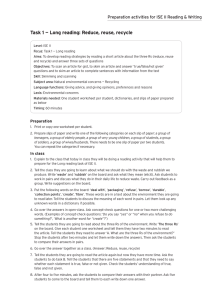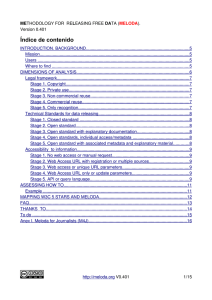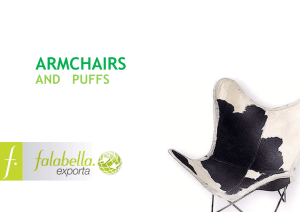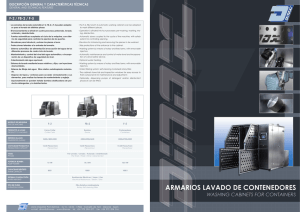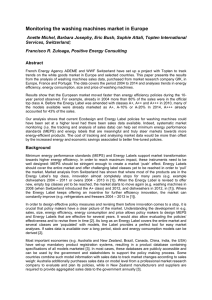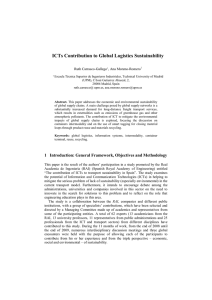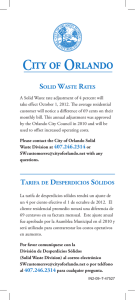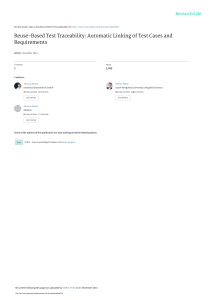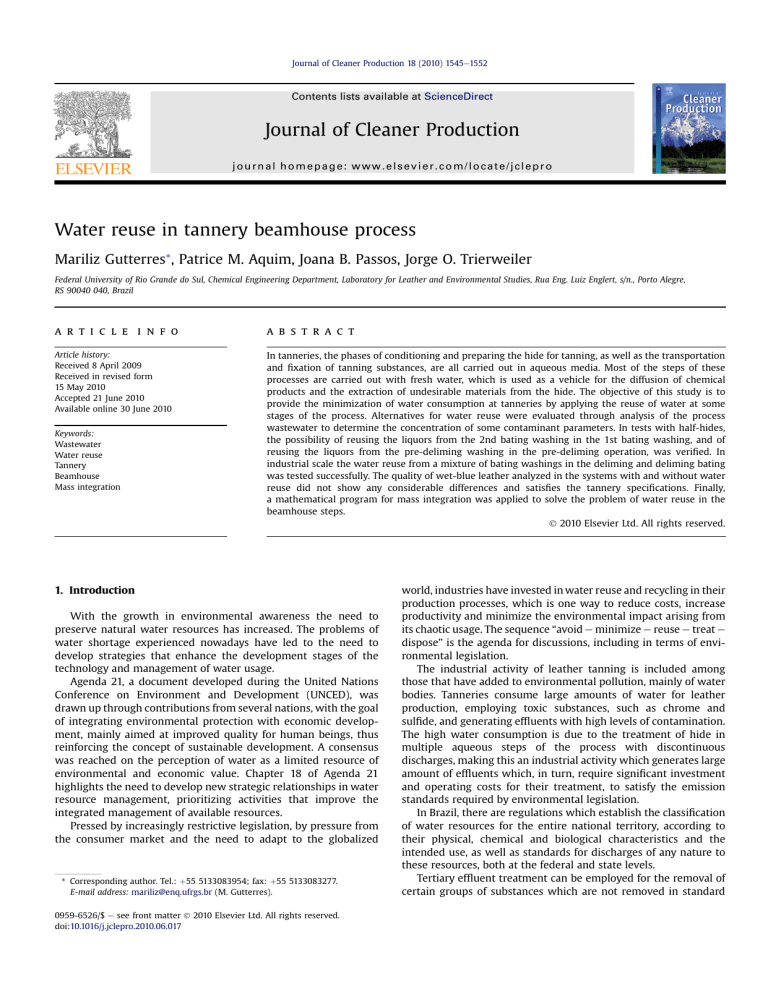
Journal of Cleaner Production 18 (2010) 1545e1552 Contents lists available at ScienceDirect Journal of Cleaner Production journal homepage: www.elsevier.com/locate/jclepro Water reuse in tannery beamhouse process Mariliz Gutterres*, Patrice M. Aquim, Joana B. Passos, Jorge O. Trierweiler Federal University of Rio Grande do Sul, Chemical Engineering Department, Laboratory for Leather and Environmental Studies, Rua Eng. Luiz Englert, s/n., Porto Alegre, RS 90040 040, Brazil a r t i c l e i n f o a b s t r a c t Article history: Received 8 April 2009 Received in revised form 15 May 2010 Accepted 21 June 2010 Available online 30 June 2010 In tanneries, the phases of conditioning and preparing the hide for tanning, as well as the transportation and fixation of tanning substances, are all carried out in aqueous media. Most of the steps of these processes are carried out with fresh water, which is used as a vehicle for the diffusion of chemical products and the extraction of undesirable materials from the hide. The objective of this study is to provide the minimization of water consumption at tanneries by applying the reuse of water at some stages of the process. Alternatives for water reuse were evaluated through analysis of the process wastewater to determine the concentration of some contaminant parameters. In tests with half-hides, the possibility of reusing the liquors from the 2nd bating washing in the 1st bating washing, and of reusing the liquors from the pre-deliming washing in the pre-deliming operation, was verified. In industrial scale the water reuse from a mixture of bating washings in the deliming and deliming bating was tested successfully. The quality of wet-blue leather analyzed in the systems with and without water reuse did not show any considerable differences and satisfies the tannery specifications. Finally, a mathematical program for mass integration was applied to solve the problem of water reuse in the beamhouse steps. 2010 Elsevier Ltd. All rights reserved. Keywords: Wastewater Water reuse Tannery Beamhouse Mass integration 1. Introduction With the growth in environmental awareness the need to preserve natural water resources has increased. The problems of water shortage experienced nowadays have led to the need to develop strategies that enhance the development stages of the technology and management of water usage. Agenda 21, a document developed during the United Nations Conference on Environment and Development (UNCED), was drawn up through contributions from several nations, with the goal of integrating environmental protection with economic development, mainly aimed at improved quality for human beings, thus reinforcing the concept of sustainable development. A consensus was reached on the perception of water as a limited resource of environmental and economic value. Chapter 18 of Agenda 21 highlights the need to develop new strategic relationships in water resource management, prioritizing activities that improve the integrated management of available resources. Pressed by increasingly restrictive legislation, by pressure from the consumer market and the need to adapt to the globalized * Corresponding author. Tel.: þ55 5133083954; fax: þ55 5133083277. E-mail address: [email protected] (M. Gutterres). 0959-6526/$ e see front matter 2010 Elsevier Ltd. All rights reserved. doi:10.1016/j.jclepro.2010.06.017 world, industries have invested in water reuse and recycling in their production processes, which is one way to reduce costs, increase productivity and minimize the environmental impact arising from its chaotic usage. The sequence “avoid e minimize e reuse e treat e dispose” is the agenda for discussions, including in terms of environmental legislation. The industrial activity of leather tanning is included among those that have added to environmental pollution, mainly of water bodies. Tanneries consume large amounts of water for leather production, employing toxic substances, such as chrome and sulfide, and generating effluents with high levels of contamination. The high water consumption is due to the treatment of hide in multiple aqueous steps of the process with discontinuous discharges, making this an industrial activity which generates large amount of effluents which, in turn, require significant investment and operating costs for their treatment, to satisfy the emission standards required by environmental legislation. In Brazil, there are regulations which establish the classification of water resources for the entire national territory, according to their physical, chemical and biological characteristics and the intended use, as well as standards for discharges of any nature to these resources, both at the federal and state levels. Tertiary effluent treatment can be employed for the removal of certain groups of substances which are not removed in standard 1546 M. Gutterres et al. / Journal of Cleaner Production 18 (2010) 1545e1552 processing systems. Most tanneries do not perform these tertiary operations, like nitrogen and phosphorus removal, activated carbon adsorption, separation membrane processes or disinfection. Aloy and Vulliermet (1997) tested the nanofiltration of tannery waste discharges for the recovery of trivalent chrome from the effluents. The authors tested two types of wastewater from the retanning processes. In both cases the results were positive, and in the case of wastewater containing residual chrome almost 100% of the chrome content was held by the membranes in tests carried out in the laboratory. Nazer et al. (2006) proposed modifications to the hair removal/liming step, in which the wastewaters from this stage are reused, decreasing the quantity of chemicals and water required. The method proposed by the authors uses fresh water in the first batch of the process and the effluent generated is reused up to four times without changing the final quality of the leather. The proposed process reduces the economic and environmental costs. Raghava et al. (2003) presented possibilities for the recycling and reuse of water at each stage of leather tanning. According to the authors, the leather industry requires around 30e40 L water per kg of skin processed, 35% is consumed by the washing and 57% in the steps of tanning and retanning. Maioli and Silva (2000) studied the reuse of wastewater from the retanning stage after its filtration through leather wastes from the shaving process. Leathers obtained with this water reuse showed characteristics similar to those retanned with fresh water. Vedaraman et al. (2003), concerned about the large amount of water used in tanning, studied the use of seawater in leather processing, and a pretreatment for the seawater was developed for its use in certain tanning steps. Two main approaches are generally used to address the issue of the systematic design of a water recovery network, i.e., the graphical approach (more commonly known as the water pinch technique) and mathematical programming approach. The first attempt to solve the water recovery network problem in a systematic way was reported by Takama et al. (1980) for a petroleum refinery case study. Utilizing a mathematical programming approach, these authors firstly set up a superstructure of all waterusing operations. This superstructure is then optimized to remove the irrelevant and uneconomical options. Wang and Smith (1994) later initiated the water pinch technique based on the more generalized problem of mass exchange network synthesis (MENS). In this two-step procedure, the limiting composite profile is introduced to locate the minimum fresh water and wastewater flow rates prior to any network design. The opportunities for regenerationereuse and regenerationerecycling were also explored. The basic concept underlying this approach is that the water-using processes are modeled as mass transfer operations. Over the past decade, a new methodology has been developed which is capable of systematically minimizing waste and improving overall process efficiency. This approach, known as process integration, was pioneered by El-Halwagi and coworkers (e.g., Gabriel and El-Halwagi, 2005; Dunn and El-Halwagi, 2003; El-Halwagi, 1997; El-Halwagi et al., 2005). It is a holistic approach to the optimal allocation, generation, and separation of streams and species within a process. Mass integration involves the optimal allocation of species (e.g., water, process compounds, non-process elements) throughout the process and provides an excellent framework for developing cost-effective pollution-prevention strategies. The essence of mass integration is to understand the global mass flow within a process and develop optimal strategies for the various species and streams within the process. Ponce-Ortega et al. (2009) presented a new formulation and a mathematical programming model for the direct recycle and reuse of mass exchange networks considering simultaneously process and environmental constraints. The model is based on mass and property integration. The properties constrained by the sinks Table 1 Basis of the process formulation. Step of the process Water (%) Chemical products Pre-deliming Pre-deliming washing Deliming/bating 100 100 200 1st Bating washing 2nd Bating washing Tanning 100 100 50 Tanning washing 100 Ammonium sulfate e Deliming salts, degreasing agents, enzymes e e Sodium chloride, sodium formate, sulfuric acid, chromium sulfate, basification agent e include composition, density, viscosity, pH, and reflectivity, whereas the environmental constraints include the composition for hazardous materials, toxicity, chemical oxygen demand, color, and odor. The results showed that even for a large size problem, the computation effort is relatively small as a result of the linearization procedure. Gomes et al. (2007) presented a heuristic procedure to synthesize water mass exchange networks. In addition, using mathematical programming techniques, Savelski and Bagajewicza (2000) proposed models to solve the recycle and reuse problem. Differently, Bai et al. (2007) employed to optimize water reuse a single-contaminant graphical method. The technology of mathematical programming is a technique in which the engineer needs less prior knowledge to understand how the units of the system are built, however, good knowledge is required to support the decision making process. Examples of the application of mathematical programs for mass integration include the studies of Savelski and Bagajewicza (2000) who reported the optimum conditions for the use of water from refineries and other plants with problems related to multicomponents. Also, Farenzena et al. (2005) worked with mass integration using mathematical programming with one contaminant, focused on leather production. Green hide Green hide Liming Liming Fleshing and Spliting Fleshing and Spliting Pre- Deliming Pre- Deliming Pre- Deliming Washing Pre- Deliming Washing Deliming/ Bating Deliming/ Bating 1st Bating Washing 1st Bating Washing 2nd Bating Washing 2nd Bating Washing Tanning Tanning Wet-blue Wet-blue Fig. 1. Flowchart of pilot tests on water reuse. M. Gutterres et al. / Journal of Cleaner Production 18 (2010) 1545e1552 1547 Green hide Liming Fleshing and Spliting Pre- Deliming Pre- Deliming Washing Deliming/ Bating 1st Bating Washing Fig. 3. Schematic representation of superstructure. 2nd Bating Washing Tanning Wet-blue Fig. 2. Flowchart of industrial test of water reuse. Hul et al. (2007) appointed the advancement of various stochastic approaches for water network synthesis as an alternative to the use of deterministic techniques. The authors utilized a developed particle swarm optimization approaches (PSO) to solve the mixed integer nonlinear programming (MINLP) model in a water network to find the minimum fresh water and wastewater flow rates for each for a given set of topology constraints. Foo (2007) addressed problems for single and multiple impure fresh water feed using the numerical targeting tool of water cascade analysis (WCA) technique. Tan et al. (2009) proposed a novel superstructure-based optimization for the synthesis of a water network with a single partitioning regenerator, while allowing for the possible reuse/recycle of both lean regenerated and reject streams from the regenerator, and the discussion is restricted to single-contaminant systems in which a single measure of stream quality (e.g., total solids or COD) reflect the aggregate level of a number of individual contaminants. The objective function was the minimization of the total system fresh water requirement subjected to the material balance. To illustrate the proposed method, four different cases studies based on examples from literature were tested. The model automatically selected which streams are best to be regenerated to achieve the minimum value of fresh water input or total cost. Given the large water consumption of the tanning process, and the importance of water in general, an in-depth study of processing hides with reduced water demand is required. This study examined the concentrations of contaminants in wastewater from the beamhouse and tanning process and tests were performed on the reuse of the water in pilot and industrial scales. A previous study from Gutterres et al. (2008) was carried out to quantify the water demand of six tanneries in the beamhouse, tanning and posttanning stages. Another study by Gutterres et al. (2005) evaluated the electrical energy and thermal energy consumptions, fuel consumption and steam generator production in nine tanneries. In addition to the possibility of implementing a system that could make the industry more competitive, the objective was to identify an industrial sector with the potential use of natural gas. The processing steps tested were: liming, pre-deliming, deliming/bating, washing. These steps are called beamhouse operations. The tests were carried out up to the tanning stage to obtain the leather and assess its quality. Liming is performed for the removal of hair and the epidermis and the opening up the skin/hide by combined sulfide and hydrated lime liquor. Deliming is the removal of lime from the hide with chemical deliming agents. Bating is a further loosening and peptizing of the fiber texture and elimination of alkali swelling with the aid of specific enzymes. Tanning is the irreversible stabilization of dermic substances by cross-linking the collagen chains with tanning agents. In this study, tanning includes pickling to acidifying the hide to a certain pH before chrome tanning. Fleshing is a mechanical step to remove the subcutis of the hide. Splitting is carried out in a splitting machine to divide the hide into two layers, grain and flesh. Finally, wet-blue leather is chrome leather in a humid state before finishing. In pilot-scale tests, the possibility of reusing the liquors from the 2nd bating washing in the 1st bating washing, and reuse the liquors from the pre-deliming washing in the pre-deliming operation was Table 2 Analysis of wastewater streams for the test with fresh water for the pre-deliming. Step pH Conductivity (mS/cma) Turbiditya (NTU) Calcium (g L1) Total solids (mg L1) Fixed solids (mg L1) Volatile solids (mg L1) Chromium oxide (g L1) Pre-deliming Pre-deliming washing Deliming/bating 1st bating washing 2nd bating washing Tanning 9.71 9.60 8.05 8.05 8.07 3.80 4.3 2.4 11.9 7.0 4.3 24.8 5.4 2.4 3.2 1.8 1.3 0.4 0.40 0.12 0.50 0.27 0.12 6064 2660 10934 4766 2512 28312 2840 996 4048 1676 1088 24952 3224 1664 6886 3090 1424 3360 e e e e e 0.022 a b Dilution 2:100. Not detected. b 1548 M. Gutterres et al. / Journal of Cleaner Production 18 (2010) 1545e1552 Table 3 Analysis of wastewater streams for the test reusing water from the pre-deliming washing in the pre-deliming. Step pH Conductivity (mS/cma) Turbiditya (NTU) Calcium (g L1) Total solids (mg L1) Fixed solids (mg L1) Volatile solids (mg L1) Chromium oxide (g L1) Pre-deliming Pre-deliming washing Deliming/bating 1st Bating washing 2nd Bating washing Tanning 9.75 9.68 8.13 8.13 8.12 9.75 6.1 3.7 12.0 8.6 4.8 6.1 8.9 4.2 3.7 2.0 1.3 0.3 0.55 0.23 0.68 0.42 0.22 9956 4776 11702 6214 3506 22834 4028 1134 4098 2236 1426 19628 5928 3642 7604 3978 2080 3206 e e e e e 0.016 a b b Dilution 2:100. Not detected. verified. In industrial scale the water reuse from a mixture of bating washings in deliming and deliming/bating was tested. Finally, a mathematical program for mass integration was applied to solve the problem of water reuse in the beamhouse steps. means 100% water reuse in these steps, with no new fresh water or mixing. The reuse was not applied to the liming, since the reuse of water from this step has previously proved to be successful and is currently practiced in tanneries in Brazil. 2. Materials and methods 2.2. Tests for water reuse in industrial scale The research for testing the water reuse was carried out in two experimental scales: pilot and industrial. The technology and chemical formulation, shown on Table 1, were obtained from a tanning company used as a case study and represent the current industrial process. Wastewater samples were collected at the end of each step. Considering the environmental aspects of water contamination and quality standards for wet-blue leather, chemical analyses were selected for these tests. The analyses chosen are important because several chemicals are added and other substances are drawn from the hide in the beamhouse and tanning stages. To characterize the wastewater streams the following parameters were determined: pH, conductivity, turbidity, calcium, total solids, fixed solids, volatile solids and chrome. To characterize the wet-blue leather the contents of water, dermic substances, dichloromethane-extractable substances, chromium and calcium were analyzed. According to the formulation, the demand for fresh water for the entire processing of a batch of 4200 kg of hide in a drum is 31,500 L and the water demand only for the steps before the tanning is 25,200 L. The test in industrial scale followed the flowchart shown in Fig. 2. For this test green hides were also used. The hides were processed for hair removal/liming in a drum at the tannery, which has the capacity to process a batch of 15,000 kg of skin, with a rotation of between 3 and 4 rpm. All the limed hides were cut out from the butt and fleshed, as is the normal procedure during leather production. From the same hides, 10 right halves were identified and sent to the drum to perform the deliming to tanning steps without water reuse and 10 left halves were sent to another drum to test the water reuse. This second drum has a processing capacity of 4200 kg of hide and a rotation of between 7 and 8 rpm. A reservoir was employed to collect the 1st and the 2nd bating washings. As they were added in the same proportions in the process formulation, the mixture contained 50% 1st bating washings and 50% 2nd bating washings. The reuse of the mixture was tested as the input to make up the entire water quantity for the predeliming step and the entire water quantity for the deliming/bating step. After the finishing of each step samples of wastewater were collected. The production of all hides and, in particular, the identified twin halves was assessed for comparison at the end of the process. 2.1. Tests for water reuse in pilot scale During the experiments the first steps to prepare the hides, liming, fleshing and splitting, were carried out in industrial scale. Two hides were cut out from the butt in two halves (left and right) and placed in pilot reactors (drums) for two experiments. For each experiment, one half was processed with normal (fresh) water and the other with 100% water reused from the liquors of defined steps without pretreatment. The water for reuse was collected from the production units in the tannery. The viable reuse of all the liquor from the 2nd bating washing in the 1st bating washing, and all of the liquor from the pre-deliming washing in the pre-deliming operation (Fig. 1) was tested. This 2.3. Mass integration and mathematical programming for water reuse Processes integration is a holistic methodology used in the process design, and the modification and improvement of already existing processes and operations, to improve the exploitation of mass and energy, with emphasis on the process units. For each pollutant there are sources (i.e., streams that carry the species), and consumers, (i.e., units that can accept the species). A consumer can be a reactor, heater, cooler, treatment station, residue discharge, etc. Streams that leave the consumers become sources. Thus, consumers also generate the species indicated. Generally, the Table 4 Analysis of wet-blue leather for the test reusing water reuse from the pre-deliming washing in the pre-deliming. Wet-blue leather %Water %Dermic substancea %Extractable with dichloromethanea %Chromium Oxidea %Calciumb Half-hide (water reuse) Half-hide (without reuse) Tannery specifications 66.2 66.9 e 86.7 88.7 e 0.41 0.34 Maximum 0.7 4.45 4.38 3.5 b a b Dry basis. Not detected. b b M. Gutterres et al. / Journal of Cleaner Production 18 (2010) 1545e1552 1549 Table 5 Analysis of wastewater streams for the test with fresh water in the deliming/bating. Step pH Conductivity (mS/cma) Turbiditya (NTU) Calcium (g L1) Total solids (mg L1) Fixed solids (mg L1) Volatile solids (mg L1) Chromium oxide (g L1) Pre-deliming Pre-deliming washing Deliming/bating 1st Bating washing 2nd Bating washing Tanning 9.36 9.55 8.71 8.61 8.62 3.70 8.9 4.3 12.6 5.3 2.9 23.1 6.5 4.2 6.2 2.3 1.7 0.3 0.44 0.19 0.66 0.15 0.05 7300 7022 13046 4980 1680 17659 5554 4416 4716 1780 120 14435 1746 2606 8330 3360 1560 2987 e e e e e 0.023 a b b Dilution 2:100. Not detected. sources are prepared for use in the consumers, which present restrictions in the concentration of species, through segregation and separation. Effective pollution prevention can be achieved through the combination of segregation, mixing, recycling and reuse of streams. The construction of the superstructure must contemplate all the possible units and connections between the units that are candidates for an optimum design. Fig. 3 shows a schematic representation of the superstructure containing all the possible alternatives, considering only the reuse of chains. Mass balance equations used to find solutions for water recovery present nonlinearities of the bilinear type. Thus, with the objective of minimizing the water demand, the formulation of these problems is naturally of the NLP (Nonlinear Programming) type. The formulation of the problem here presented was based on the work of Fontana (2002). With the primary objective of reducing the water consumption in systems containing “n” units that make use of water, the following formulation is generally proposed. The objective function is represented in equation (1). min F ¼ X Fi (1) i˛fCg subject to the following restrictions: X Fi ¼ i˛fCg NoU X Wi @ i¼1 NoP X X NoP X NoP X SMi;j þ Louti ¼ j¼1 :Mi;j þ Lini (3) j¼1 with: SMi,j ¼ 0, to i˛fCg and j ¼ 1, ., NoP, Mi,j ¼ 0, to i˛fRg and j ¼ 1, ., NoP, where: Lin, inlet mass flow rate; Lout, outlet mass flow rate. Mass balance around the stream mixer e equation (4). Fk þ NoU X Lk;i ¼ Link (4) isk where Lk,i is the mass flow rate of the recycle/reuse stream that flows from unit i to unit k. Mass balance around each node of stream division e equation (5). Wk þ N oU X Li;k ¼ Loutk (5) isk (a) Global Mass Balance e equation (2). 0 (b) In the formulation of the problem other restrictions imposed on the system are related to: Mass balance in each unit e equation (3); where Li,k is the mass flow rate of the recycle/reuse stream that flows from unit k to unit i 1 :M i;j A (2) i˛fCg j ¼ 1 where: F, mass flow rate of fresh water; W, mass flow rate of wastewater; M, mass flow rate of pollutant that enters the processes; NoU, total number of units that make use of water (NoU ¼ NoC); {C}, set of the units that use water. (c) Component mass balance around each node of stream mixing e equation (6). XFj ,Fk þ NoU X Xouti;j ,Lk;i ¼ Xink;j ,Link (6) isk where:XF, concentration of pollutant in fresh water;Xin, concentration of pollutant that enters in the units;Xout, concentration of pollutant that exits the units. Table 6 Analysis of wastewater streams for the test reusing water from the 1st bating washing in the deliming/bating. Step PH Conductivity (mS/cma) Turbiditya (NTU) Calcium (g L1) Total solids (mg L1) Pre-deliming Pre-deliming washing Deliming/bating 1st Bating washing 2nd Bating washing Tanning 9.31 8.88 10.6 5.8 8.5 4.1 0.67 0.53 10,332 4900 5768 2374 4564 2526 8.04 7.35 7.11 3.60 13.6 7.3 3.7 22.8 6.0 2.0 1.4 0.4 0.63 0.21 0.05 16,518 5612 2080 18,590 5834 1886 818 15,498 10,684 3726 1262 2769 a b Dilution 2:100. Not detected. b Fixed solids (mg L1) Volatile solids (mg L1) Chromium oxide (g L1) e e e e e 0.019 1550 M. Gutterres et al. / Journal of Cleaner Production 18 (2010) 1545e1552 Table 7 Analysis of wet-blue leather for the test reusing water from the 1st bating washing in the deliming/bating. Wet-blue leather %Water %Dermic substancea %Extractable with dichloromethanea %Chromium Oxidea %Calciumb Half-hide (water reuse) Half-hide (without reuse) 65.3 66.6 95.9 91.3 0.40 0.52 4.1 3.4 b a b b Dry basis. Not detected. Component mass balance around each uniteequation (7) SMi;j þ Xouti;j ,Louti ¼ :M i;j þ Xini;j ,Lini 3. Results (7) Restrictions in each unit that make use of water: m ax , to i˛fCg and j ¼ 1, ., NoP, and Xini;j Xin i;j Lsupi ¼ Lini , to i˛fCg Restrictions in each unit that make use of water. The hypotheses of the model are the following: all the make up water leaves the system in the form of liquid effluent; only the processes admit fresh water; the species involved do not interact with each other. The search for the minimum water consumption is based on economic criteria since the lower the water demand of the system, the less the operational cost. Also, minimizing the water consumption, the amount of wastewater to be treated and discarded is less, causing less impact on the environment. The problem was solved with software GAMS 22.2 and the optimum solution was given by MINOS solver. The mass integration was applied to the steps before the tanning operation with the aim of not mixing the currents with the chrome. The primary contaminant of these steps is calcium, since it is the element which should be removed in these operations, and, therefore, its residual content in leather must be monitored. The presence of calcium affects the leather quality, causing its rigidity. The other contaminants, principally volatile solids due to the organic substances that are extracted from the hide, do not negatively affect the hide, because the enzymes produced during the beamhouse operations aid the hide cleaning. Two situations were simulated for the mass integration. Firstly, it was considered that in each step the contaminant could enter in the same operation in the concentration in which it exited. In the second integration, the concentrations considered were based on the experimental tests for reuse (Fig. 2). 3.1. Tests for water reuse in pilot scale Tables 2 and 3 show the characterization of all wastewater streams during the experiment to test the water reuse from the pre-deliming washing to the pre-deliming step. The pH values with and without reuse are similar. To promote the chemical changes in the hide in each step, it is important to control the pH value and to correct it if necessary. The results show that the largest concentrations of calcium oxide were found in the liquors of the pre-deliming and deliming/ bating due to extraction and removal of the calcium content from the hide in these steps. In the reuse test, the amount of calcium found is a little higher, since the water reused already contains calcium. In the test in which the reuse was applied the values found for the total solids were higher. The content of total solids is the sum of the fixed and volatile solids. The values found for fixed solids for the tests with and without reuse were much closer. The volatile and total solids with reuse were higher than without reuse, due to the presence of residual organic matter in the former. Conductivity is related to the fixed solids content; it indicates the quantity of salt compounds in the effluents. The conductivity results followed the same trend as the fixed solids and the values with and without reuse were close. Turbidity can be linked to both the organic matter and dissolved salts. The turbidity results followed the same trends as those for the total solids. In the pre-deliming step the difference between the tests with and without reuse is greater because the reuse was applied in this step, and this difference subsequently decreases. The values for residual chromium oxide after the tanning stage were very low, meaning that much of the chrome overall was chemically bound to the collagen molecules of the hide. Analysis of the wet-blue leather (Table 4) was carried out to establish the levels of these substances in the leather and to verify its quality. The value for dermic substances based on collagen (protein content) is very important to the experiment, because this is the Table 8 Analysis of wastewater streams for the water reuse tests with a mixture of bating washings in deliming and deliming/bating and without reuse in industrial scale. Step Water reuse pH Pre-deliming Pre-deliming washing Deliming/bating 1st Bating washing 2nd Bating washing Tanning Tanning washing Mixture of bating washings Conductivity (mS/cma) Calcium (g L1) Total solids (mg L1) Fixed solids (mg L1) Volatile solids (mg L1) Chromium oxide (g L1) Yes No Yes No Yes No Yes No Yes No Yes No Yes No 9.9 9.7 9.1 9.0 8.9 3.0 3.7 e 11.1 11.1 8.8 9.6 9.5 3.7 3.7 9.0 10.8 7.6 12.6 9.9 6.9 35.4 23.8 e 7.8 6.3 14.4 10.4 7.0 37.3 24.8 9.2 1.38 0.75 0.92 0.57 0.33 e e e 0.75 0.56 0.64 0.53 0.30 e e 0.43 22,494 10,918 23,460 9972 5562 82,296 35,352 e 12,040 10,100 21,482 9684 3496 78,912 37,196 8618 11,120 5638 8084 3480 1606 73,410 30,180 e 6092 4520 8364 3694 1378 68,570 31,788 3950 11,374 5280 15,376 6492 3956 8886 5172 e 5948 5580 13,118 5990 2118 10,342 5408 4668 e e e e e 1.35 0.567 e e e e e e 1.222 0.631 e M. Gutterres et al. / Journal of Cleaner Production 18 (2010) 1545e1552 1551 Table 9 Information for the contaminant calcium in the process to resolve the mass integration. Step Mass of calcium in the process step (kg) Limit of calcium concentration entering the step e First Integration (g L1) Limit of calcium concentration entering the step e Second Integration (g L1) Limit of calcium concentration exiting the step (g L1) Pre-deliming Pre-deliming washing Deliming/bating 1st Bating washing 2nd Bating washing 5.80 3.15 7.73 2.39 1.39 0.75 0.56 0.64 0.53 0.30 0.01 0.43 0.43 0.01 0.01 1.38 0.75 0.92 0.57 0.33 principal component of the hide that comprises the leather. The difference between the wet-blue leather twin halves was very small and within the experimental error of the analysis. The value for dichloromethane-extractable substances quantifies the remaining undesirable fat contents. For both tests the values were lower than the maximum values of the specifications. The reused water carried a quantity of calcium which could prevent the calcium removal from the hide, however, the results showed that the calcium was successfully removed, i.e., without the need to increase the length of the deliming step or for further additions of chemical deliming agents. The chrome is the tanning agent that reacts with the collagen tissue of the dermic substances to achieve irreversible stabilization of the hide which is otherwise susceptible to deterioration. For this reason, the minimum acceptable quantity in leather according to the specifications is 3.5%. The results of the analysis after tanning are in agreement with this value. In the next pilot experiment the reuse of the liquor from the 1st bating washing in the deliming/bating was tested (Tables 5e7). The liquors from the test with reuse had higher calcium values and the results for chromium oxide in these tests were very close. The volatile solids had higher values for the steps with reuse, principally for the deliming/bating, and after the 1st bating washing the difference decreased. The steps from the test with reuse showed more fixed solids due to the calcium content. The pH, conductivity and turbidity values for the liquors from the test with reuse were close to those without reuse. For the half-hide obtained with water reuse the dermic substances value was higher than the other half obtained without reuse, both within the specified values. The amount of calcium contained in the wet-blue leather was very low and not detected by the analysis. The results for dichloromethane-extractable substances, calcium and chromium were within the specifications for tanning, and the quality of the wet-blue leather was not affected by the reuse. 3.2. Tests for water reuse in industrial scale The results of chemical analysis of wastewater for the water reuse test in industrial scale are given in Table 8. The pH values with reuse are lower than those without reuse. This is associated with the pH adjustment; however, they are within the recommended values for efficiency in each step. The results found for the conductivity for both tests were similar. Values found for calcium were higher in the case of reuse due to the residual calcium in the liquors, but this difference decreases during the process until no calcium is detected. The results for chromium oxide found for the two tests are very close. The volatile solids results show that the test with reuse had higher values for some steps and lower values for others; this is due to the presence of fibers and organic matter from the hide that remained in the liquor. The results for fixed solids were very close for the two systems, as were those for the total solids content. The wet-blue leather from the two batches with and without water reuse showed good quality, consistent with the specifications of the tannery. The contents of dermic substances, dichloromethane-extractable substances, chrome oxide and calcium were not affected by the reuse system. On comparing the twin halves of the 10 hides, they showed good visual quality, smooth surface appearance, with no lose grains and no spots from fats or chrome hydroxide. In this experiment the use of fresh water for deliming and deliming/bating was eliminated. In general, 750% of water enters this industrial process, while reuse avoids the use of 200%. This represents a reduction of 27% in the water demand of the beamhouse steps. Fig. 4. Water reuse streams proposed from the mass integration. 1552 M. Gutterres et al. / Journal of Cleaner Production 18 (2010) 1545e1552 Table 10 Economy (water saving) estimated by the mass integration. Water demand (L) Contaminant Original process Integrated process Economy (%water) Calcium e 1st integration Calcium e 2nd integration Volatile solids 25,200 25,200 25,200 17,184 18,733 10,114 31.81 25,66 59.86 As the process at the beamhouse aims principally to clean the hide and to eliminate non-collagen proteins, it is an extraction process which needs water as the solvent media. The objective of water reuse is not to economize or recycle chemical reagents, since these should be removed from the hide by reacting with the impurities. Alternatives for clean technology include the partial or total substitution of sulfides, surfactants, lime and other chemicals employing enzymes and other auxiliaries, as reported by Aquim et al. (2008) who evaluated the costs of chemicals and wastewater treatment. 3.3. Mathematical programming for water reuse The data applied to the formulation of the problem were obtained from the production data of the tannery processing a 4200 kg batch of hide before tanning, which requires 25,200 L of fresh water. On selecting calcium as the limiting factor for the reuse, this component having a great influence on the operations under study, the concentration limits were obtained from the experimental data of Table 9. Fig. 4 presents the reuses from the results of the mass integration for calcium as the priority contaminant in the first and second integration. Table 10 shows the water demand and its saving with calcium as the contaminant. The decrease in fresh water demand was 32% for the first integration and 26% for the second integration. The combination of more contaminants will not affect the water saving result. The value of 26% is in good agreement with the water saving of 27% achieved in the experiments in industrial scale, confirming the feasibility of considering only calcium as a contaminant. 4. Conclusions Testing in pilot scale enables the hide behavior to be verified at each step of the process and an easy comparison between twin half-hides with and without water reuse. Leathers obtained in the tests satisfied the tannery specifications, that is, their quality was unaffected. The reuse of the liquors from the 2nd bating washing in the 1st bating washing, and of the liquors from the pre-deliming washing in the pre-deliming operation, was found to be feasible. In the process in industrial scale the experiments also showed the feasibility of reusing a mixture of bating washings without pretreatment in the deliming and deliming/bating steps. The reuse reduced by 27% of the consumption of water required in the beamhouse steps. It was detected that in production scale the differences in water contamination between the systems with and without reuse were smaller than in the case of pilot scale. This is because of the differences between the compositions of the green hides at a larger scale are offset by the processing. The results from the production scale tests were of great value, providing an excellent opportunity to implement this water reuse system for the preservation of fresh water. The company in this case study in large scale has applied the reuse strategy purposed. The mathematical programming based on mass integration was solved successfully in the search for water reuse solutions to achieve minimum water consumption. Acknowledgements The authors gratefully acknowledge the Tannery Bom Retiro Group and the National Council for Scientific and Technological Development (CNPq). References Aloy, M., Vulliermet, B., 1997. Membrane technologies for the treatment of tannery residual floats. Congress of the International Union Leather Technologists and Chemists Societies, London, pp. 659e666. Aquim, P.M., Gutterres, M., Mancopes, F., Trierweiler, J.O., 2008. Environmental and economic evaluation of technologies for the process of hides and leather. Latin American Congress of Leather Technologists, Rio de Janeiro. Bai, J., Feng, X., Deng, C., 2007. Graphically based optimization of single-contaminant regeneration reuse water systems. Chem. Eng. Res. Des. 85 (A8), 1178e1187. Dunn, R.F., El-Halwagi, M.M., 2003. Process integration technology review: background and applications in the chemical process industry. J. Chem. Tech. Biotech. 78, 1011e1021. El-Halwagi, M.M., 1997. Pollution Prevention Through Process Integration: Systematic Design Tools. Academic Press, San Diego, pp. 1e190, 217e247. El-Halwagi, M.M., Glasgow, I.M., Eden, M.R., Qin, X., 2005. Property integration: componentless design techniques and visualization tools. AIChE J. 50 (8), 1854e1869. Farenzena, M., Ferreira, L.S., Trierweiler, J.O., Aquim, P.M., 2005. Tanneries: from waste to sustainability. Braz. Arch. Biol. Technol. 48, 281e289. Fontana, D., 2002. Recovery from waters of processddevelopment of a standard problem. Dissertation MSc., Federal University of Rio Grande do Sul, Porto Alegre, Brazil. Foo, D.C.Y., 2007. Water cascade analysis for single and multiple impure fresh water feed. Trans IChemE. Part A. Chem. Eng. Des 85 (A8), 1169e1177. Gabriel, F., El-Halwagi, M.M., 2005. Simultaneous synthesis of waste interception and material reuse networks: problem reformulation for global optimization. Environ. Prog. 24 (2), 171e180. Gomes, J.F.S., Queiroz, E.M., Pessoa, F.L.P., 2007. Design procedure for water/ wastewater minimization: single contaminant. J. Cleaner Prod. 15 (5), 474e485. Gutterres, M., Aquim, P.M., Passos, J.B., Severo, L., Trierweiler, J., 2008. Reduction of water demand and treatment cost in tanneries through reuse technique. J. Am. Leather Chem. Assoc. 103, 138e143. Gutterres, M., Schneider, P.S., Vielmo, H.A., Marcílio, N.R., Danieli, R., Conceição, S.T., 2005. Using natural gas to supply energy using co-generation. Leather Intern. 206, 25e30. Hul, S., Tan, R.R., Auresenia, J., Fuchino, T., Foo, D.C.Y., 2007. Trans. IChemE. Part B. Proc. Safety Environ. Prot. 85 (B6), 507e514. Maioli, P., Silva, A., 2000. Reuse of residual water from retanning in a closed system. Leather Magazine ABQTIC 130, 46e60. Nazer, D.W., Al-Sa’, R.M., Siebel, M.A., 2006. Reducing the environmental impact of the unhairingeliming process in the leather tanning industry. J. Cleaner Prod. 14, 65e74. Ponce-Ortega, J.M., El-Halwagi, M., Jimenez Gutierrez, A., 2009. Global optimization for the synthesis of property-based recycle and reuse networks including environmental constraints. Comp. Chem. Eng. doi:10.1016/j. compchemeng.2009.10.005. Raghava, R.J., Chandrababu, N.K., Muralidharan, C., Nair, B.U., Rao, P.G., Ramasami, T., 2003. Recouping the wastewater: a way forward for cleaner leather processing. J. Cleaner Prod. 11, 591e599. Savelski, M.J., Bagajewicza, M.J., 2000. On the optimality of water utilization systems in process plants with single contaminants. Chem. Eng. Sci. 55, 5035e5048. Tan, R.R., Ng, D.K.S., Foo, D.C.Y., Aviso, K.B., 2009. Proc. Safety Environ. Prot. 87, 197e205. Takama, N., Kuriyama, T., Shiroko, K., Umeda, T., 1980. Optimal water allocation in a petroleum refinery. Comp. Chem. Eng. 4, 251e258. Vedaraman, N., Iyappan, K., Ramalingam, S., Muralidharan, C., Rao, P.G., 2003. Use of seawater in leather processing. J. Am. Leather Chem. Assoc. 98, 333e336. Wang, Y.P., Smith, R., 1994. Wastewater minimization. Chem. Eng. Sci. 49, 981e1006.
